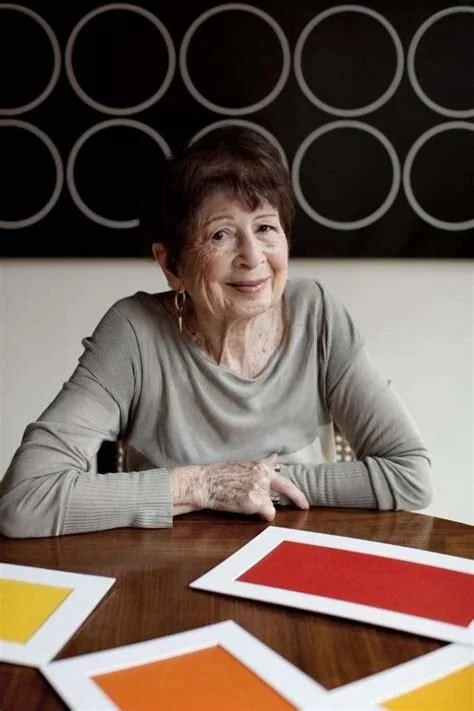A native of Stockholm, Sweden, Siri Berg was born in 1921. While attending the German Gymnasium and Victoria College in Prague she took life drawing classes at the Rotter-Schule für Werbegrafik. She then entered The Institute of Art and Architecture at the University of Brussels before immigrating to the United States at the age of 19. Siri worked briefly in interior design until she began pursuing her true passion—painting and color.
The inspiration for her work combines the graceful clarity of Swedish craftsmanship with the clean lines of modern design. Siri’s art consists of three main bodies of work including paintings, collage (which are made through a mastering of the technique of Japanese woodblock prints) and assemblages (constructed from industrial objects found in surplus bins located on Canal Street, New York).
Siri’s introduction to color stems from her study with Zita Querido (1917-2003), an Austrian born artist and former pupil of Hans Hofmann who taught at the Riverdale Fine Arts Society near where Siri lived and raised her two sons. Beyond this introduction, a central motif of Siri’s work evolved from an early series of paintings featuring a phasing of a circle inspired by the Austrian Arthur Schnitzler’s theatrical and controversial play La Ronde (1897). Another early series titled Phases were ruminations by the Irishman W. B. Yeats’ A Vision (1925). This book-length study by Yeats gave Siri the philosophical, historical, astrological, and poetic grounding upon which she would build an oeuvre spanning six decades.
Color became her calling card as she meticulously moved first through a series of all black, then all white canvases. She then gradually shifted to generate color charts and then mixing her own paint. Color and texture gave way to personal stories told through an embracing of total abstraction. Inspired by the theories put forward by Johannes Itten and Josef Albers, Siri took hold of their statements turning out her own theories ranging from bold and fast-forward to subdued and slow in motion.
In the first years of her artistic development, she concentrated on the subject of the The Ten Sefirot of the Kabbalah—the attributes in Kabbalah through which The Infinite is revealed to create both the physical realm and the chain of higher metaphysical realms. Reinterpreting this, Siri used color, value and design to express an ascending and descending order through value gradations from dark to light.
In the tradition of abstract geometric painting, Berg’s work is noted for its purity. In her Kabbalah Series and Empty Spaces Series she explored, through progressions and variation, the systematic evolution of a theme.
Never at ease with industrial manufactured paints, Siri mixed her own. Color as composition became her lasting interest.
That what I think each color does for me. I didn’t like 24 colors on a wheel and I didn’t like 12. I found that from 1 to 9, I could do a perfect gradation. —Siri Berg, 2014
Siri taught Color Theory at Parsons School of Design for over 30 years and was featured in the book “100 New York Painters” (by Cynthia Maris Dantzic, Schiffer Publishers). In 1999, Professor Joel Lebowitz endowed a Series to fund the Estelle Lebowitz Visiting Artist in Residence Program. With these funds, the Series mounted exhibitions and hosted campus visits by Siri Berg. Other invited artists included Carolee Schneeman, June Wayne, Hung Liu, Miriam Schapiro, Molly Snyder-Fink, May Stevens, Bernie Searle, Renee Cox, Cecilia Vicuña, and Joan Snyder. Siri was a long-time member of the American Abstract Artists.
Significant monographic presentations include: The American Swedish Museum, Philadelphia (’86, ‘99); The Yeshiva University Museum, New York (’91); The Robert C. Williams American Museum, Atlanta (’97); Swedish American Museum, Chicago (’03); Gibson Gallery Museum at SUNY Potsdam (’06); The William Whipple Art Museum at Southwest Minnesota State University, Marshall (’08); The Painting Center, New York (’12); Shirley Fiterman Art Center, New York (’16); The Bonniers Konsthall Museum, Stockholm (’18); Swedish Embassy, Washington, DC (’19).
Prominent public collections include The Solomon R. Guggenheim Museum, New York; Southwest Minnesota State University Art Museum MN; New York University, New York; Gray Art Gallery, NYU, New York; Moderna Museet (Museum of Modern Art), Stockholm, Sweden; The Swedish Ambassador’s Residence in Washington D.C., among others.
Siri Berg lived and worked in New York City’s SoHo district until her death in 2020.

